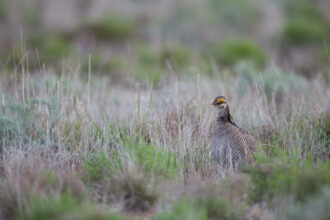From the shortgrass prairies in the west to the tallgrass prairies in the east, rangeland ecosystems occupy a whopping 46 percent of Nebraska’s 49.5 million acres. University of Nebraska graduate student Kyle Martens was a teenager at the height of the corn commodity boom and enjoyed stories about the great grasslands as a kid.
“To think that over one million square miles with some of the richest species diversity could one day disappear is troubling. It was difficult to see large swaths of habitat–areas I had explored and hunted in my formative years-practically disappear overnight,” recalled Martens. “As part of a natural system, these landscapes can provide income for ranching operations and employment in rural communities; habitat for grassland plants, animals, and migratory species; and offer other services not always readily observed such as improved soil health, clean water, and carbon sequestration. Despite the overarching benefits, the conversion of grasslands to other uses remains widespread throughout much of the remaining Great Plains ecosystem.”
Martens is working to better understand ranchers’ preferences regarding grassland conservation programs in Nebraska. In 2020, he received a $7,926 NCR-SARE Graduate Student grant to learn which elements of a hypothetical payment for ecological services (PES) program could lead to adoption by Nebraska ranchers.
Partnering with Nebraska Extension, Nebraska Cattlemen’s, Nebraska Grazing Lands Coalition, and the Nebraska Game and Parks Commission, Martens developed and distributed a survey to gather feedback directly from ranchers. They looked primarily at preferences for management actions, payment amounts, and contract lengths in voluntary conservation programs.
Key Survey Findings
- Participants preferred management actions that were tied to practices known to improve biological diversity.
- Ranchers showed strong preferences for the types of management actions that were incentivized and were less concerned about the accompanying contract length or payment.
- The least preferred practices were related to the management of water resources on the ranch.
“Of all of the 16 management actions we tested, using grazing to conserve biodiversity was preferred over all other possible program options,” said Martens. “This suggests not only that biodiversity is a recognized term within Nebraska’s ranching community, but it also indicates ranchers see biodiversity as a management strategy that can coexist with the core business of livestock production.”
Understanding why the least preferred conversation practices were related to water management requires understanding that water supply and delivery may need a delicate management approach. Martens suggested that a conservation program like PES could look for more ways to specifically address biodiversity needs in relation to aquatic resource management.
“For example, rather than consultations on individual impaired species, it may be more effective to highlight the overall net decline of the aquatic ecosystem and what these declines tell us about water quality and landscape health,” said Martens.
Advancing Conservation
Nebraska producers enrolled 350,981 acres through the 2021 Grassland CRP signup, coming in third behind Colorado and South Dakota. That seems promising, but Martens shared a 2015 study that shows that the rate of conversion in remaining temperate grassland is occurring five times faster than what can be protected currently (Lipsey et al., 2015).
Survey results suggested the need to offer flexible conservation programs that reflect the challenges of cattle ranching in a natural grassland system. Martens hopes that stakeholders from ranching, conservation, and the private sector will come together to lay the foundation of a payment for ecosystem programs (PES) marketplace in Nebraska. He suggested collaborative trust networks as part of a leveraged approach. The approach could also include developing pilot locations statewide which could eventually serve as information exchanges among potential program participants.
“Conservation planners must work with ranchers to develop the long-term, cost-effective policy and practices we’ll need on the farms and ranches of the future,” said Martens. “Not only do these programs need to achieve the measurable conservation and delivery of ecosystem services, but these programs need to enhance profitability and demonstrate congruency with ranching lifestyles.”
